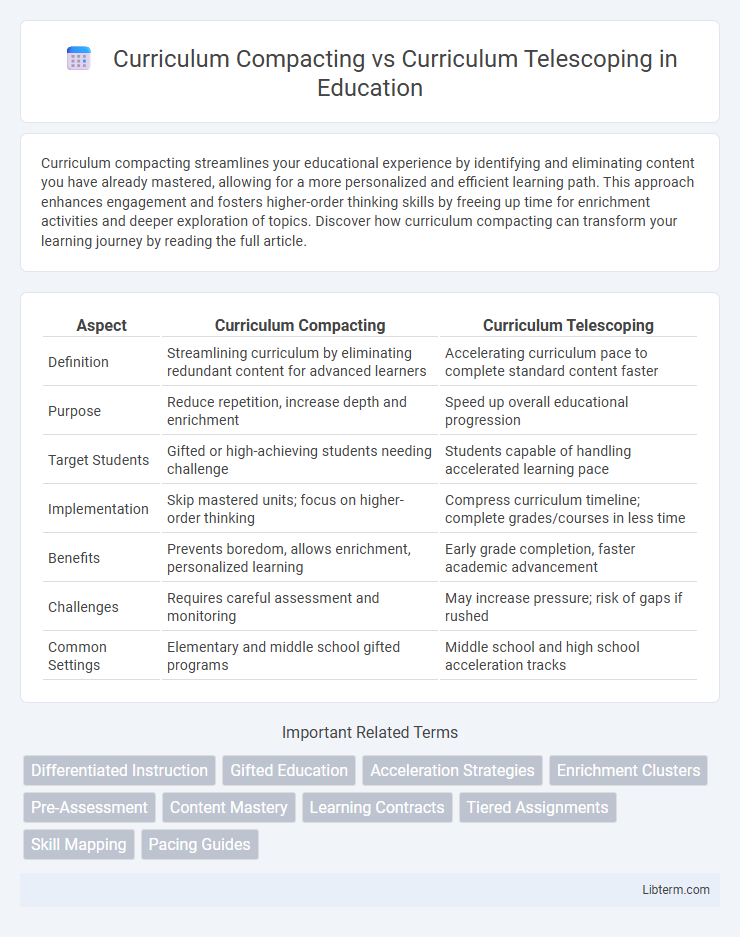Curriculum compacting streamlines your educational experience by identifying and eliminating content you have already mastered, allowing for a more personalized and efficient learning path. This approach enhances engagement and fosters higher-order thinking skills by freeing up time for enrichment activities and deeper exploration of topics. Discover how curriculum compacting can transform your learning journey by reading the full article.
Table of Comparison
| Aspect | Curriculum Compacting | Curriculum Telescoping |
|---|---|---|
| Definition | Streamlining curriculum by eliminating redundant content for advanced learners | Accelerating curriculum pace to complete standard content faster |
| Purpose | Reduce repetition, increase depth and enrichment | Speed up overall educational progression |
| Target Students | Gifted or high-achieving students needing challenge | Students capable of handling accelerated learning pace |
| Implementation | Skip mastered units; focus on higher-order thinking | Compress curriculum timeline; complete grades/courses in less time |
| Benefits | Prevents boredom, allows enrichment, personalized learning | Early grade completion, faster academic advancement |
| Challenges | Requires careful assessment and monitoring | May increase pressure; risk of gaps if rushed |
| Common Settings | Elementary and middle school gifted programs | Middle school and high school acceleration tracks |
Understanding Curriculum Compacting
Curriculum Compacting streamlines traditional instruction by identifying and eliminating redundant or already mastered content, allowing students to focus on advanced or enriched material tailored to their individual learning needs. This method enhances student engagement and academic growth by providing differentiated learning opportunities while maintaining curriculum integrity. Understanding Curriculum Compacting involves recognizing its role in optimizing instructional time and promoting efficient skill development within standard educational frameworks.
What is Curriculum Telescoping?
Curriculum telescoping is an educational strategy that accelerates the learning process by compressing the standard curriculum into a shorter time frame, allowing students to complete the material more quickly than usual. This approach is often used for gifted or advanced learners who demonstrate mastery of content, enabling them to skip over redundant instruction without sacrificing comprehension or depth. Unlike curriculum compacting, which removes repetitive elements but maintains the original pace, telescoping restructures the timeline, speeding up progression through the curriculum.
Key Differences Between Compacting and Telescoping
Curriculum compacting involves reducing the amount of instructional time by eliminating content students already know, allowing them to focus on enrichment activities, whereas curriculum telescoping accelerates the pace by covering multiple grade-level standards in a shorter time frame. Compacting customizes learning by assessing prior knowledge to streamline content, while telescoping fast-tracks curriculum delivery to enable early grade completion. The key difference lies in compacting's emphasis on content elimination based on mastery and telescoping's focus on accelerated progression through traditional content.
Goals and Objectives of Each Approach
Curriculum compacting aims to reduce redundancy by eliminating material students have already mastered, allowing acceleration in areas where they need further development, with the primary goal of maintaining grade-level standards while optimizing instructional time. In contrast, curriculum telescoping compresses the entire curriculum into a shorter timeframe, intending to expedite learning for advanced students by covering all grade-level objectives rapidly without omitting content. Both approaches focus on differentiation but vary in strategy: compacting prioritizes mastery and enrichment within existing timelines, whereas telescoping targets overall acceleration and early completion of curricular goals.
Techniques for Implementing Curriculum Compacting
Curriculum compacting involves streamlining the existing curriculum by identifying and eliminating redundant content, allowing advanced students to engage in more challenging material without repeating what they already know. Techniques for implementing curriculum compacting include pre-assessment to determine mastered skills, modifying assignments to emphasize higher-order thinking, and providing enrichment activities that extend learning beyond the standard curriculum. This approach enhances student motivation and promotes efficient use of instructional time by tailoring learning experiences to individual readiness levels.
Strategies for Effective Curriculum Telescoping
Curriculum telescoping streamlines traditional grade-level content into a shortened timeframe, allowing advanced learners to progress faster through essential subjects. Effective strategies include pre-assessment to identify mastery, individualized pacing plans to match student readiness, and focused instructional sessions targeting core learning objectives. Incorporating ongoing progress monitoring and flexible grouping ensures students remain challenged while avoiding content gaps.
Benefits of Curriculum Compacting for Gifted Learners
Curriculum compacting benefits gifted learners by reducing repetition of mastered content, allowing more time for enrichment and acceleration. This approach enhances engagement and motivation by tailoring the curriculum to individual learning speeds and interests. It supports deeper understanding and fosters advanced critical thinking skills through differentiated instruction.
Advantages of Curriculum Telescoping in Education
Curriculum telescoping accelerates the learning process by compressing multiple grade levels into a shorter time frame, enabling gifted students to progress faster without gaps in their education. This approach promotes enhanced academic engagement and motivation by challenging students at their appropriate skill level, reducing boredom associated with standard pacing. Schools implementing curriculum telescoping benefit from optimized resource allocation and personalized learning paths, fostering higher achievement and better preparation for advanced studies.
Challenges and Considerations for Educators
Curriculum compacting challenges educators to accurately assess student mastery to avoid unnecessary repetition while ensuring critical skills are retained, requiring ongoing formative assessments and differentiation strategies. Curriculum telescoping demands careful pacing to cover accelerated content without overwhelming students, which involves balancing depth and breadth of topics and providing targeted support to maintain comprehension. Both approaches necessitate continuous monitoring of student progress and flexible instructional planning to effectively meet diverse learner needs.
Choosing the Right Approach for Student Needs
Curriculum compacting streamlines content by eliminating redundancies, allowing gifted students to engage with material at a suitable pace, whereas curriculum telescoping accelerates the entire curriculum, enabling students to complete grade-level work faster. Selecting the right approach depends on the learner's depth of understanding and readiness to handle accelerated content without gaps in knowledge. Personalized assessment of student strengths and areas for growth ensures the most effective method supports academic development and motivation.
Curriculum Compacting Infographic

 libterm.com
libterm.com